Chapter 2 Kings and Queens 英美文化概论 教学课件
- 格式:ppt
- 大小:1.63 MB
- 文档页数:33
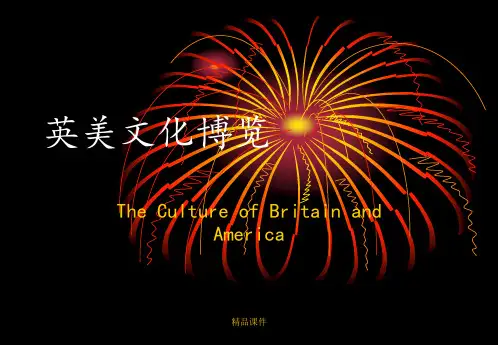
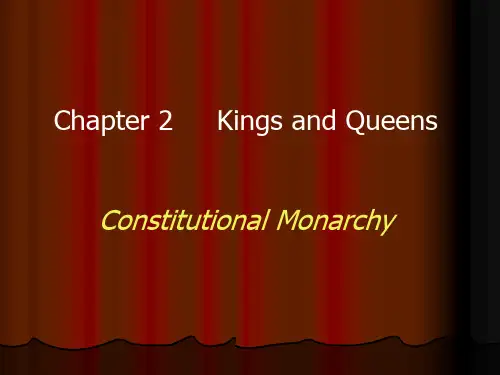

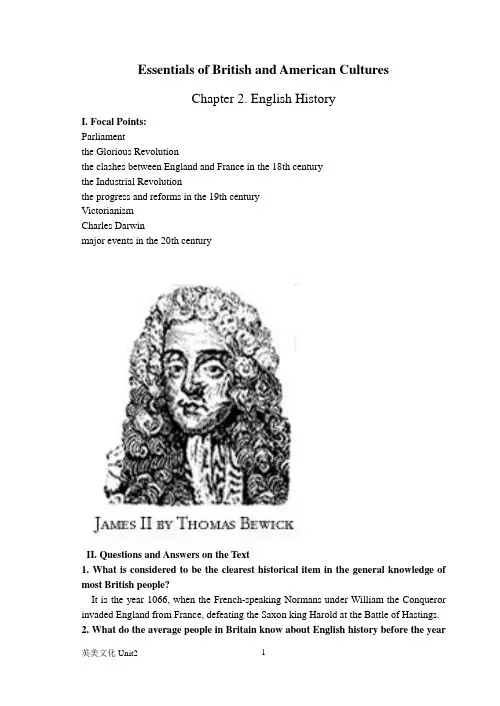
Essentials of British and American CulturesChapter 2. English HistoryI. Focal Points:Parliamentthe Glorious Revolutionthe clashes between England and France in the 18th centurythe Industrial Revolutionthe progress and reforms in the 19th centuryVictorianismCharles Darwinmajor events in the 20th centuryII. Questions and Answers on the Text1. What is considered to be the clearest historical item in the general knowledge of most British people?It is the year 1066, when the French-speaking Normans under William the Conqueror invaded England from France, defeating the Saxon king Harold at the Battle of Hastings.2. What do the average people in Britain know about English history before the year1066?They know about the Romans and they are sure to know the story of the fine Saxon king, Alfred the Great, and the legendary stories of the still earlier king Arthur and his Knights of the Round Table.3. Who was the most famous of the English Crusaders?The most famous of the English Crusaders was the Norman king, Richard Lion-Heart.4. In the Middle Ages, who were the great rivals of the king's authority?The great rivals of the king's authority were the Church and the powerful local chiefs, called barons.5.Why was the Pope in the Middle Ages so powerful?Because the Pope in Rome could always inspire the fear of eternal damnation by "excommunicating" (i. e. expelling from the Church) a king or even a whole nation; the Pope also wielded great political power over the whole of Western Europe.6.How did the French drive the English from their country at the end of the One-hundred-year War?The French drove the English from their country partly through the inspiration of the brave girl Joan of Arc, and partly through the effective use of guns, which had only just been invented.7. In English history, what language did the kings of the Middle Ages speak as their mother tongue? What changes took place after the Hundred Years' War?All the kings of the Middle Ages spoke French as their mother tongue. After the Hundred Years' War, England became completely severed from France, and the English language finally took the place of French in all classes of society.8.What were the characteristics of the sixteenth century as the beginning of the modern period in English history and European history?In the sixteenth century, the invention of printing made books much easier to produce and therefore much cheaper, so that ideas could spread quickly. It was the age of the great voyages of discovery and the beginning of the imperialist expansion; it was also the beginning of freedom of thought in the Christian religion.9.In the sixteenth century, what changes took place in religion?The sixteenth century was the beginning of the freedom of thought in the Christian religion, when the decline in the Pope's political power was followed by a decline in his religious authority.10. What was the result of the decline in the Pope's political power and religious authority in the sixteenth century?As a result of the decline in the Pope's political power and religious authority, Protestant churches sprang up in Northern Europe in opposition to the established Roman Catholic Church, and Protestant-Catholic hatred became a constant theme in European history.11. Who delivered the first great blow to the Roman Catholic Church in England?It was Henry VIII who delivered the first great blow to the Roman Catholic Church in England.12. How did the English Church break away from the central organization of Christianity?The long quarrel between the Pope and Henry VIII on the matter of Henry VIII's divorce ended in Henry VIII's declaring that he and not the Pope was the head of the Church in England. As a result, the English Church broke away from the central organization of Christianity.13. What is meant by "heresy" in the sixteenth century?It refers to any revolt against the traditional Christian faith. It was held by Catholics that "heresy" was the work of the devil and should be resisted by the most violent means.14. When did Protestantism gradually become the dominant faith in Britain?Protestantism gradually became the dominant faith in Britain in the reign of Elizabeth I, whose main interest lay in creating a strong united country in which there should be no more religious persecution.15. What were the characteristics of the Elizabethan age?It was an age of literature, especially the literature of Shakespeare, and an age of adventure on the sea.16. Which country was the biggest enemy of England in the sixteenth century?Spain was the biggest enemy of England in the sixteenth century.17. What was the most important event in the English history in the seventeenth century?The most important event in the English history in the seventeenth century was the English Revolution.18. What was the conflict between King Charles I and Parliament before the Civil War?Charles I believed he had a "Divine Right" to govern, while Rarliament believed he was a human being answerable to the people. For a time, Charles I actually ruled without parliament, and levied taxes without Parliament's approval.19. Who were the "Roundheads"? Why were they nicknamed "Roundheads" ?The "Roundheads" were the nickname of the "Puritan" elements, those with very strict Protestant principles. They were supporters of the Parliament. They were nicknamed the "Roundheads" because of the bare look of their shorn heads contrasted with the long, curly wigs of the King's more fashionable supporters, the "Cavaliers". 20. Who were the "Cavaliers"?The "Cavaliers" were the supporters of King Charles I, those who had long, curly wigs.21. Who was the Roundhead leader?The Roundhead leader was Oliver Cromwell.22. What was the consequence of the English Civil War?The Civil War led to the execution of Charles I and the temporary overthrow of the monarchy, when the country became for more than ten years a sort of republic founded by Oliver Cromwell.23. When did the Glorious Revolution take place?The Glorious Revolution took place in 1688.24. Who was the Britain's great enemy during the whole of the eighteenth century?Britain' s great enemy during the whole of the eighteenth century was France.25. What were the two most famous victories that Britain had over France during the eighteenth century?The two most famous victories were the Battle of Waterloo over the great Napoleon, and the Battle of Trafalgar over Napoleon' s fleet.26. What is meant by "meet one' s Waterloo"? What is the origin of the phrase?The phrase "meet one's Waterloo" means "encounter final disaster''. It comes from the Battle of Waterloo, the famous victory won by Britain over Napoleon.27. What is considered to be the most important event in the eighteenth century in Britain?The Industrial Revolution is considered to be the most important event in the eighteenth century in Britain.28. What was the most important invention during the Industrial Revolution?The most important invention during the Industrial Revolution was the invention of the steam engine.29. What was Britain's main historical interest after the Battle of Waterloo?Britain's main historical interest was in the efforts made (a) to overcome social problems, (b) to make Parliament more representative of the people, and (c) to improve local government and social services.30. What do "Peelers" or "bobbies" refer to?The word "Peeler" or "bobby" comes from the name of a person, Sir Robert ("Bobby") Peel, who founded the modern police force of Britain. So policemen are called "Peelers", or rather affectionately "bobbies."31. What is meant by "franchise"?Franchise means the right to vote in elections.32. How long did the Victorian age last?The Victorian age lasted 64 years from 1837 to 1901.33. What impact did Charles Darwin's The Origin of Species have on the Victorian age?Darwin's theory of evolution caused violent reaction from the religious Victorians who believed every deeply in God as the Creatorr of Man and in the life after death.Furious debates were Held both in private and in public, and Darwin's theory was destined to outlive Victorianism and contribute to its decay.34. How did the Victorian stability collapse after the death of Queen Victoria ?The Victorian stability collapsed within a few years of the death of Queen Victoria. The working classes rose up to fight for their rights and the women woke up to fight for the right to vote. Meanwhile the trouble in Ireland was going from bad to worse.35. According to the author, how did Britain get involved in World War I?Britain became involved because she had made friends with her old enemy, France, who was being attacked by Germany.36. What were the two most disasterous events in British economy between the two World Wars?They were the General Strike in 1926 and the great "slump" of the early 1930s.37. What became the threat of the international situation after the great "slump" ?After the great "slump", fascism became the threat of the international situation.38. Who were the two big fascists before and during the Second World War?The two big fascists were Mussolini in Italy and Hitler in Germany.39. What was the consequence of Hitler' s constant thirst for power?What was the basis of Hitler's constant thirst for power?Hitler's constant thirst {or power led Europe into the Second World War. The basis of Hitler's constant thirst for power was the idea of a German "master-race".40. How long did the First World War last? How long did the Second World War last?The First World War lasted 4 years from 1914 to 1918. The Second World War lasted 6 years from 1939 to 1945.41. What is meant by the "blitz" of 1940?It refers to the bombing of Britain by German planes in 1940, when Hitler sent his bombers day after day to bomb airfields and towns in the south, and then night after night, to bomb London.III. Explanations1.King HaroldThe Saxon king who was defeated and killed at the Battle of Hastings in 1066, when the French-speaking Normans under William the Conqueror invaded England from France.2. Alfred the Great(1)He was a fine Saxon king who successfully defeated the invading Danes.3. King Arthur( 1 ) He was the king of England in the sixth century. (2) Little was known about him,except that he was associated with Corn- wall and is the central figure of many legends about him and his Knights of the Round Table.4. The CrusadesThe Crusades were a series of wars in the Middle Ages in which armies from all over Europe tried to snatch the "Holy Land" ( i.e. Palestine, where Jesus Christ once lived) from the Infidels (i.e. the Muslims).5. Richard Lion-Heart( 1 ) He was a Norman king in the Middle Ages. (2) He was also the most famous of the English Crusaders at that time. (3) Many stories have been told about him and his enemy Saladin.6. the Magna Carta( 1 ) The Magna Carta (or Great Charter) was a document signed in 1215 by King John under compulsion by the powerful barons. (2) The purpose of the Charter was to make King John to recognize the rights of the barons. (3) The Magna Carta is now in the British Museum, London.7. the Hundred Years' War(1) A war between England and France which lasted, on and off, for a hundred years from 1337 to 1453. (2) It was fought entirely in France, and the whole of France very nearly fell into English hands in the famous battles of Crecy and Agincourt. (3) Eventually, partly through the inspiration of the brave girl Joan of Arc, and partly through the effective use of guns, the French drove the English from their land for good.8. Joan of Arc(1) She was a French saint and national heroine. (2) During the Hundred Years' War, her bravery and inspiration provided spirit and morale for French armies. (3) Later she was captured and burned at the stake.9. the Wars of the Roses(1) It is the name given to the struggle (1455--1485) for the throne of England between two branches of the English royal family: (2) the houses of Lancaster, whose badge was a red rose, and York, whose badge was a white rose. (3) The wars weakened both the nobility and the monarch.10. the Catholic Church(1) It refers to the Christian church headed by the Pope. (2) All members of the church accept the gospel of Christ and the teachings of the Bible. Any revolt against the traditional Christian faith was "heresy." (3) In the Middle Ages, the Pope was extremely powerful. (4) In the sixteenth century, some of the actual beliefs and practices of the Catholic Church Were questioned by Protestant doctrines and there was a great deal of presecution by Catholics.11. the Protestant Church( 1 ) It refers to the Christian church whose faith and practice originated with the principles of the Reformation. (2) As the Pope’s political power and religious authority declined in the sixteenth century, Protestant churches sprang up in Northern Europe in opposition to the established Roman Catholic Church. (3) In Britain, Protestantism gradually became the dominant faith in the Elizabethan age.12. bloody Mary( I ) It was the nickname given to Mary I, Henry III' s elder daughter. (2) She was a devout Catholic, and had so many Protestants burnt to death that she is remembered less by her official title Mary I than by her nickname Bloody Mary. (3) She was succeeded by Elizabeth I.13 the Elizabethan age(I) It refers to the period during the reign of Elizabeth I in British history. (2) It was an age of real literary achievement, especially that of Shakespeare, and (3) it was an age of adventure on the sea.14. the "Gunpowder Plot"(1) It refers to the most famous of a number of Catholic conspiracies in English history which occurred in the reign of James I (2) It was the plot to blow up the King and Parliament, in which a man called Guy Fawkes was caught in the cellars of the House of Commons in the very act of preparing the explosives. (3) "Guy Fawkes' Night" is still celebrated on November 5th each year.15. the English Civil War(1) One of the most important events in the whole of British history. (2) It is a bitter power struggle (1642--1648) between the monarchy and Parliament. (3) The victory of the Parliament led to the execution (1649) of Charles I and the temporary overthrow of the monarchy, and (4) the country became for more than ten years a sort of republic founded by Oliver Cromwell.16. King Charles I(1) An English king in the seventeenth century. He believed that he had a "Divine Right" to govern. (2) For a time, Charles actually ruled without Parliament, and levied taxes without Parliament's approval. (3) This aroused the opposition of the Roundheads , and the great Civil War broke out, in which he was defeated, tried as a traitor to his country, and condemned to death.17. Oliver Cromwell(1) Oliver Cromwell was the Roundhead leader during the English Civil War. (2) He defeated King Charles I and condemned him to death. (3) The monarchy was overthrown, and the country became for more than ten years a republic.18. the Glorious Revolution(1) It refers to the event of 1688 in the English Revolution, when the Catholicking James II was forced to flee with his baby son to France. (2) The throne was offered to his Protestant daughter and her husband Dutch king William. (3) The bill of Rights was passed by Parliament to restrict the power of the Monarchy. (4) This was the beginning of the Constitutional Monarchy in Britain.19. the Industrial Revolution( 1 ) It refers to the period in British history from 1750 to 1850. (2) Great changes took place with the invention of the steam engine. (3) More factories and big towns were built. (4) It made Britain stronger and richer, and at the same time it also created entirely new social class, the industrial workers.20. the Victorian age(I) It refers to the monarch of Britain under the great Queen Victoria from 1837 to 1901, the longest reign in British history. (2) The Victorian age was an age of national development and national optimism. (3) The Victorians were very religious and conservative in family life. (4) It was also, in its later stages, an age of imperialism.21. the "suffragette" movement( 1) A term refers to the movement in the early twentieth century by the British women, who had been meek and submissive in Victorian's reign. (2) They rose up to gain their right to vote. (3) This was not simply a political campaign but a profound revolt against an inferior status.22. Charles's Darwin( I ) The famous British scientist who wrote the important book "The Origin of Species". (2) His theory of evolution caused violent reaction of the Victorians against the book, and furious ,debates were held in private and in public. (3) Darwin's theory contributed to the decay of Victorianism.。
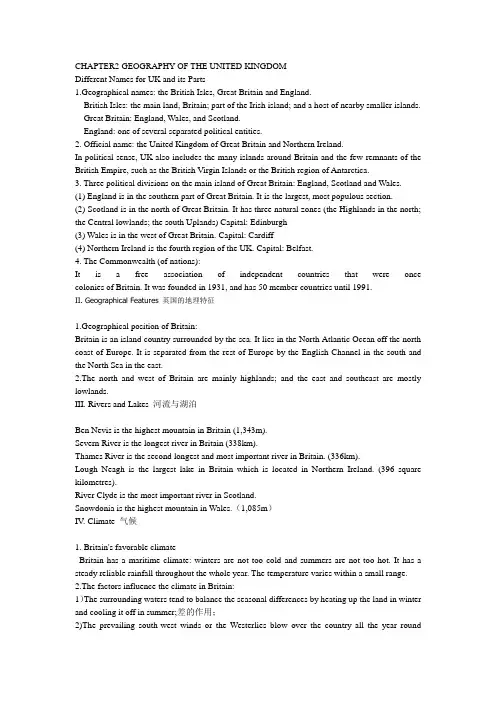
CHAPTER2 GEOGRAPHY OF THE UNITED KINGDOMDifferent Names for UK and its Parts1.Geographical names: the British Isles, Great Britain and England.British Isles: the main land, Britain; part of the Irish island; and a host of nearby smaller islands. Great Britain: England, Wales, and Scotland.England: one of several separated political entities.2. Official name: the United Kingdom of Great Britain and Northern Ireland.In political sense, UK also includes the many islands around Britain and the few remnants of the British Empire, such as the British Virgin Islands or the British region of Antarctica.3. Three political divisions on the main island of Great Britain: England, Scotland and Wales.(1) England is in the southern part of Great Britain. It is the largest, most populous section.(2) Scotland is in the north of Great Britain. It has three natural zones (the Highlands in the north; the Central lowlands; the south Uplands) Capital: Edinburgh(3) Wales is in the west of Great Britain. Capital: Cardiff(4) Northern Ireland is the fourth region of the UK. Capital: Belfast.4. The Commonwealth (of nations):It is a free association of independent countries that were once colonies of Britain. It was founded in 1931, and has 50 member countries until 1991.II. Geographical Features 英国的地理特征1.Geographical position of Britain:Britain is an island country surrounded by the sea. It lies in the North Atlantic Ocean off the north coast of Europe. It is separated from the rest of Europe by the English Channel in the south and the North Sea in the east.2.The north and west of Britain are mainly highlands; and the east and southeast are mostly lowlands.III. Rivers and Lakes 河流与湖泊Ben Nevis is the highest mountain in Britain (1,343m).Severn River is the longest river in Britain (338km).Thames River is the second longest and most important river in Britain. (336km).Lough Neagh is the largest lake in Britain which is located in Northern Ireland. (396 square kilometres).River Clyde is the most important river in Scotland.Snowdonia is the highest mountain in Wales.(1,085m)IV. Climate 气候1. Britain's favorable climateBritain has a maritime climate: winters are not too cold and summers are not too hot. It has a steady reliable rainfall throughout the whole year. The temperature varies within a small range. 2.The factors influence the climate in Britain:1)The surrounding waters tend to balance the seasonal differences by heating up the land in winter and cooling it off in summer;差的作用;2)The prevailing south-west winds or the Westerlies blow over the country all the year roundbringing warm and wet air in winter and keeping the temperatures moderate;3)The North Atlantic Drift passes the western coast of the British Isles and warms them.3.RainfallBritain has a steady reliable rainfall throughout the whole year. The average annual rainfall in Britain is over 1,000mm. There is a water surplus in the north and west, and a water deficit in the south and east.V. The People1.population distributionBritain has a population of about 57 millions and it is very unevenly distributed. 90% of the population is urban and only 10% is rural. The population of Britain is made up mainly of the English (81.5%), the Scottish (9.6%), the Welsh (1.9%), the Irish (2.4%), the Northern Irish (1.8%) and other peoples (2.8%).2.The difference between the ancestors of the English and Scots, Welsh and Irish:The ancestors of the English are Anglo-Saxons; the Scots, Welsh and Irish are Celts.3.The difference in character The Welsh are emotional and cheerful people. They are music lovers and are proud of their past.The Scots are said to be a serious, cautious and thrifty people, and they are also hospitable, generous and friendly.The Irish are charm and vivacity.。
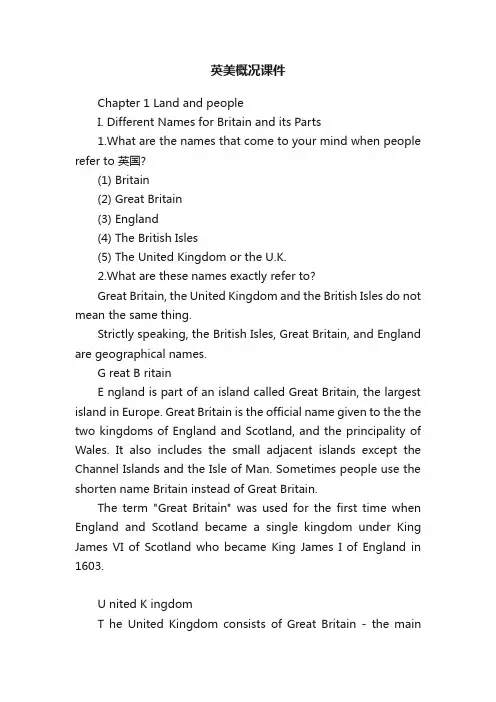
英美概况课件Chapter 1 Land and peopleI. Different Names for Britain and its Parts1.What are the names that come to your mind when people refer to 英国?(1) Britain(2) Great Britain(3) England(4) The British Isles(5) The United Kingdom or the U.K.2.What are these names exactly refer to?Great Britain, the United Kingdom and the British Isles do not mean the same thing.Strictly speaking, the British Isles, Great Britain, and England are geographical names.G reat B ritainE ngland is part of an island called Great Britain, the largest island in Europe. Great Britain is the official name given to the the two kingdoms of England and Scotland, and the principality of Wales. It also includes the small adjacent islands except the Channel Islands and the Isle of Man. Sometimes people use the shorten name Britain instead of Great Britain.The term "Great Britain" was used for the first time when England and Scotland became a single kingdom under King James VI of Scotland who became King James I of England in 1603.U nited K ingdomT he United Kingdom consists of Great Britain - the mainisland made up of England, Scotland and Wales - and Northern Ireland.The United Kingdom of Great Britain and Northern Ireland (UK) was formed in on January 1 1801 and constitutes the greater part of the British Isles. The largest of the islands is Great Britain, which comprises England, Scotland and Wales. The next largest is Ireland, comprising Northern Ireland, whichT he B ritish I slesThe British Isles include the UK, Great Britain, and other islands such as Ireland and the Channel Islands.The British Isles consists of:Great Britain (England, Scotland and Wales)The whole of IrelandThe Orkney and Shetland IslandsThe Isle of ManThe Inner and Outer HebridesThe Isle of WightScilly IslandsLundy IslandThe Channel IslandsPlus many other offshore islandsSummery:EnglandGreat Britain ScotlandWales U.K.2 large islandsNorthern IrelandBritish Isles IrelandRepublic of IrelandHundreds of (1949)small islands3.What is the official name of Britain?(1) The United Kingdom of Great Britain and Northern Island(2) For short: Britain, the United Kingdom or U.K.*The Union Jack--refers to the Union Flag or the National flag of the United Kingdom--It is called the Union Flag because it represents the emblems of the four countries united under one Sovereign - the kingdoms of England and Wales, of Scotland and of Ireland (although since 1921 only Northern Ireland has been part of the United Kingdom).--Although the name "Union Jack" is the popular name by which the flag is known to the world, it should strictly, perhaps, only be used for the flag when it is flown as a jack (a small flag flown at the bow of a ship); government documents generally prefer "union flag" as the more universally correct term4.Why do people often us e “England” and “English” to refer to “Britain” and“British”?England is the largest, post populous, and the richest.Largeness Size Pop.England biggest 60% 85%Britain Scotland 2nd largest 30% 1/10Wales smallest 9% 5%5.British imperial expansion“The sun never sets on the British Empire”(1) Ruled 1/4 of the world?s population and 1/4 of world?sland(2) Had colonies in North America, Asia, Africa, Austrialia6.British Commonwealth (Commonwealth of Nations)The term …Commonwealth? has been used to replace the word …Empire? to describe collectively the independent countries associated under the British crow(1) A free association of countries used to be English colonies(2) 53 member countries at present(3) Functions: active in a number of areas including development, democracy, debtmanagement and trade.II. Geographical features1.Geographical positionThe United Kingdom of Great Britain and Northern Ireland (UK) is situated north-west of the European continent between the Atlantic Ocean and the North Sea. It has a total land area of 244,100 square kilometres, of which nearly 99% is land and the remainder inland water. From north to south it is about 1,000 kilometres long.(1) Northwest of Europe(2) North Atlantic Ocean(3) Separated from the rest of Europe by the English Channel2.Geographical features(1) An island country, surrounded by sea(2) Highlands in the north and west(3) Lowlands in the east and southeastA. Part of the great European PlainB. Level land and fertile soilC. farming(4) 3 natural zones in ScotlandA. the highlands in the northB. the central lowlandsC. the southern uplandsIII. Rivers and LakesImportant role of rivers in the country?s economy1.Important Rivers(1)the Severn RiverA.the longest in the countryB.only 338 kilos long(2)the Thames RiverA.the 2nd longestB.the most important riverC.336 kilos longD.Oxford and London are on the river(3)River ClydeA.the most important in ScotlandB.important commercial waterway2.the Lake District(1)in northwest England and North Wales(2)popular tourist attractions(3)the home of the Lake PoetsA.William WordsworthB.Samuel Taylor ColeridgeC.Robert SoutheyIV. Climate1.Typical feature of Britain’s climate“Other countries have a climate; in England we have weather.”The statement is often made by Englishmen to describe the peculiar meteorological conditions of their country.A maritime type of climate(1)rainy---abundant rainfallThe uncertainty about the weather tends to make the Englishmen cautious.“A foreigner may laugh when he sees the Englishman setting forth on a brilliantlysunny morning wearing a raincoat and carrying an umbrella, but he may well regret hislaughter later in the day!”(2)changeable and unpredictable, no clear cut of 4 seasons“In no country other than England, it has been said, can one experience four seasons in the course of a single day! Day may break as a balmy spring morning; an hour or solater black clouds may have appeared from nowhere and the rain may be pouring down.At midday conditions may be really wintry with the temperature down by about eightdegrees or more centigrade. And then, in the late afternoon the sky will clear, the sunwill begin to shine, and for an hour or two before darkness falls, it will be summer.”(3)Mild: no extremesIn England one can experience almost every kind of weather except the most extreme.temperature: 4-6℃in winter, 12-17℃in summer2.Factors influencing the climate(1)the surrounding waters(2)the prevailing south-west winds(3)the North Atlantic Drift (warm current)3.Rainfall(1) a steady reliable rainfall throughout the year(2)uneven distribution of rainA. a water surplus in the north and westB. a water deficit in the south and eastV. The People1.Population of Britain: characteristics(1)Densely populatedVery large population for such a small country.(2)Highly urbanized90% of the population is urban and only 10% rural(3)Unevenly distributedThe population is made up mainly of (composition of British population)A.the English (81.5%)B.the Scottish (9.6%)C.the Welsh (1.9%)D.the Irish (2.4%)2.Different ancestors(1)the English----the Anglo-Saxons(2)the Scots, Welsh, and Irish----the Celts3.Differences in character and speech between southern and northern England(1)Southerners speak the type of English closer to BBC EnglishGenerally speaking, southerners speak the type of English closer to BBC English.They do not have a special accent except the Cockneys from the East End of London.(2)Northerners speak broader EnglishHowever, the northerners speak broader English than thesoutherners, and often leaveout the article “the” and the possessive adjectives “my”, “your”, “their”, etc.4.The way the Welsh keep their language and culture aliveThrough Eisteddfodau (Eisteddfod)(1)The Eisteddfod (literally 'sitting') is a Welsh festival of literature, music, and song. Thetradition of such a meeting of Welsh artists dates back to at least the 12th century.The most important eisteddfod is the National Eisteddfod, held annually and usuallyalternating between North and South Wales, and taking place entirely in the Welshlanguage.(2)The Welsh are music lovers and are proud of their past.(3)Throughout the year they have festivals of song, dance and poetry called Eisteddfod(au),hold competitions in Welsh poetry, music, singing and art to keep the Welsh languageand culture alive.Chapter 2The Origins of a Nation (5000BC-1066)I. Early Settlers (5000 BC—55BC)1. The Iberians伊比利亚人(1)Who were the first known settlers (inhabitants) of Britain?The Iberians(2)When did they come to Britain?At 3000 BC during the New Stone Age(3)How do you know that the Iberians were the firstknown settlers to Britain?A. The proof is the long barrows (古墓冢) found, which were their communal burialmounds (公墓)B. the Stonehenge (圆形巨石群、阵):a.It is a circular group of large standing stones constructed before 2000 BC.b.It is regarded as one of the most important monuments of its kind in Europe.c.Exactly why it was built is unknown but it must have had religious and politicalsignificance.(There are many different ideas about the purpose of Stonehenge: it may have beena center of sun worship, and was perhaps an observatory)d.Some think the Stonehenge is associated with the Celts.2. The Beaker Folk宽口陶器人(以其铃、钟形宽口陶器而闻名)(1) When and where were they from?At about 2000 BC (at the early Bronze Age) the Beaker Folk arrived from the areas now known as Holland and the Rhineland.(2)Why were they so called? (How did they take their name?)from their distinctive bell-shaped drinking vessels (or beakers)(3)How about their civilization? (What did they bring with them?)a)The art of pottery makingb)The ability to fashion (ornament with patterns) bronze toolsc)The custom of individual buriald)The hill forts (堡垒) and small fortified towns (筑堡城镇). TheMaiden Castle is oneof the finest examples.3. The Celts(1) Who were the ancestors of the Scots, Welsh and Irish?The Celts were the ancestors of the Scots, Welsh and Irish(2) When and where were they from?They began to arrive about 700 BC, and may have come from eastern and central Europe, now France, Belgium and Germany(3) What were these people?A.They were Practised farmers. They drained much of the marshlands and built houses ofwood and wickerwork with a weatherproof coating of mud.(带有抗风化的泥层)B.They were ironworkers.(4) What was their religion?Druidism(德鲁伊德教),the Druids—the wise men, astrologers, soothsayers(占卜者)II. Roman Britain (55BC—410AD)1. What do you know about the Roman invasion of Britain?(1)British recorded history begins with the Roman invasion.(2)In 55 BC, the great Roman general Julius Caesar invaded Britain for the first time(partly to gather information about the island and partly to punish the Belgae who helped in fighting against the conquering Roman)the invasion was unsuccessful because of resistance, the successful invasion did not take place until nearly a century(3)In AD 43, Emperor Claudius invaded successfully(4)For nearly 400 years Britain was under the Roman occupation, but it was never a totaloccupation.First, as a result of resistance; Secondly, Roman troops were often withdrawn fromBritain to fight in other parts of the Roman Empire.2. the Hadrian’s Wall哈德良长城(公元2世纪,罗马皇帝哈德良下令修建的城墙,用于防御英格兰北部边境,抵抗克尔特部落的进攻)It was one of the two great walls built by the Romans to keep the Picts out of the area they had occupied and conquered.(1)After the Roman occupation, the Romans met with fierce resistance and attacks from thetribes of Scotland. These people were called Picts(皮克特人)because of their “paintedfaces”. )(2)The Romans realized that they could not conquer them. So they withdrew from the north,and built two great walls, the Hadrian?s Wall and the Antonine Wall, to resist the attacks)3. the Roman contribution(1) they built a network of towns on their military camps with the capital of London(the suffix –caster or –chester in English place names—Lancaster, Winchester—derives from castra, the Latin word for camp.)(2) the Romans constructed a network of major and secondary roads. From London, roadsradiated all over the country.(3) The Romans made good use of Britain?s natural resources. They built baths, temples,amphitheatres and beautiful villas.(4)The Romans also brought the new religion, Christianity, to Britain.4. Why was the Roman influence on Britain so limited?Although Britain became part of the Roman Empire, the Roman impact upon the Britons was surprisingly limited as a result of(1)the Romans always treated the Britons as a subject people of slave class.(2)The Romans and the Britons never intermarried during the 4 centuries.(3)The Romans had no impact on the language or culture of ordinary Britons.III. The Anglo-Saxons (446-871) 盎格鲁-萨克逊人1. Who were the Anglo-Saxons?The Anglo-Saxons referred to the three Teutonic tribes(日而漫部落)who invaded Britain in the mid-5th century. They were Jutes, Saxons and Angles.--The Jutes 朱特人, from today?s Denmark, came to Britain first for assistance to drive outthe Picts and Scots.--Then the Saxons from northern German--The Angles who also came from northern German and were to give their name to the English people.2. How did the Heptarchy (七王国) come into being?During the Anglo-Saxon invasion, the three tribes named the Jutes, the Saxons and the Angles settled in different parts of Britain which was divided into many kingdoms. Among them, there were 7 principle kingdoms of Kent, Essex, Sussex, Wessex, East Anglia, Mercia and Northumbria. So they have been given the name of Heptarchy.3. Offa’s Dyke欧发大堤(古代英格兰的巨大土方工程。
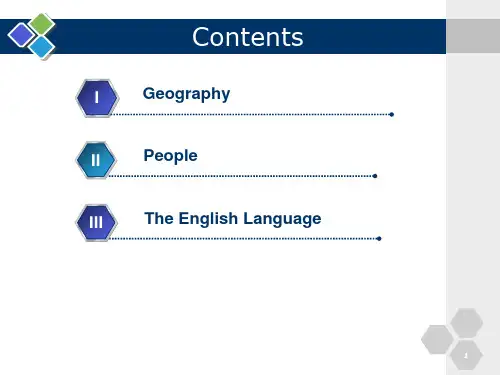
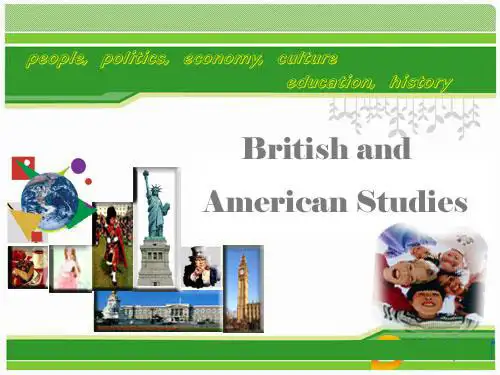
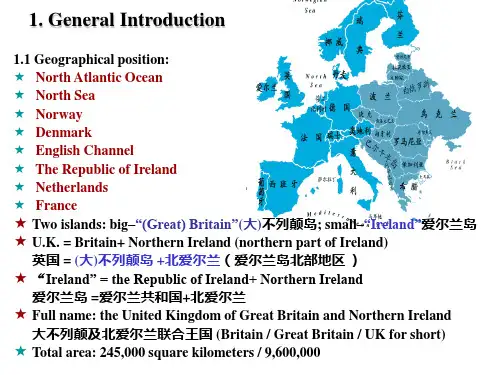
![2022[教育学]《英美文化概况》教学课件优秀ppt](https://uimg.taocdn.com/603042c409a1284ac850ad02de80d4d8d15a01bb.webp)
